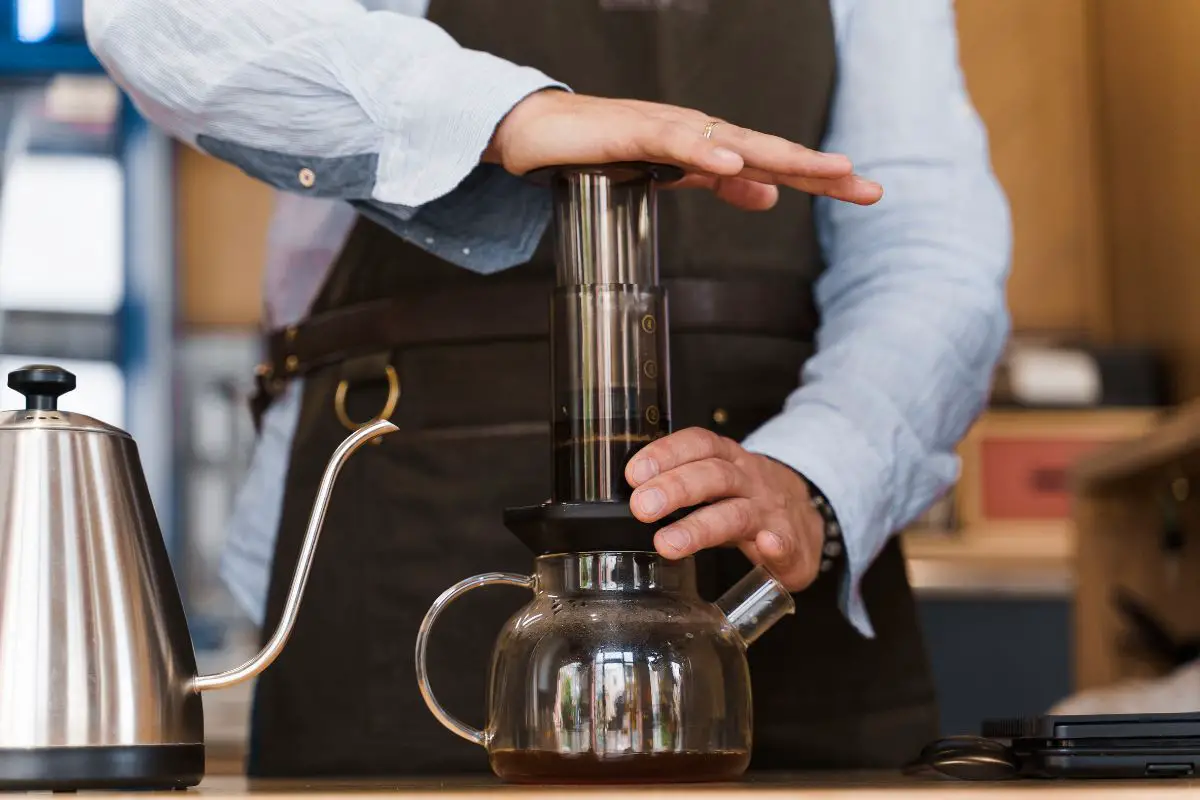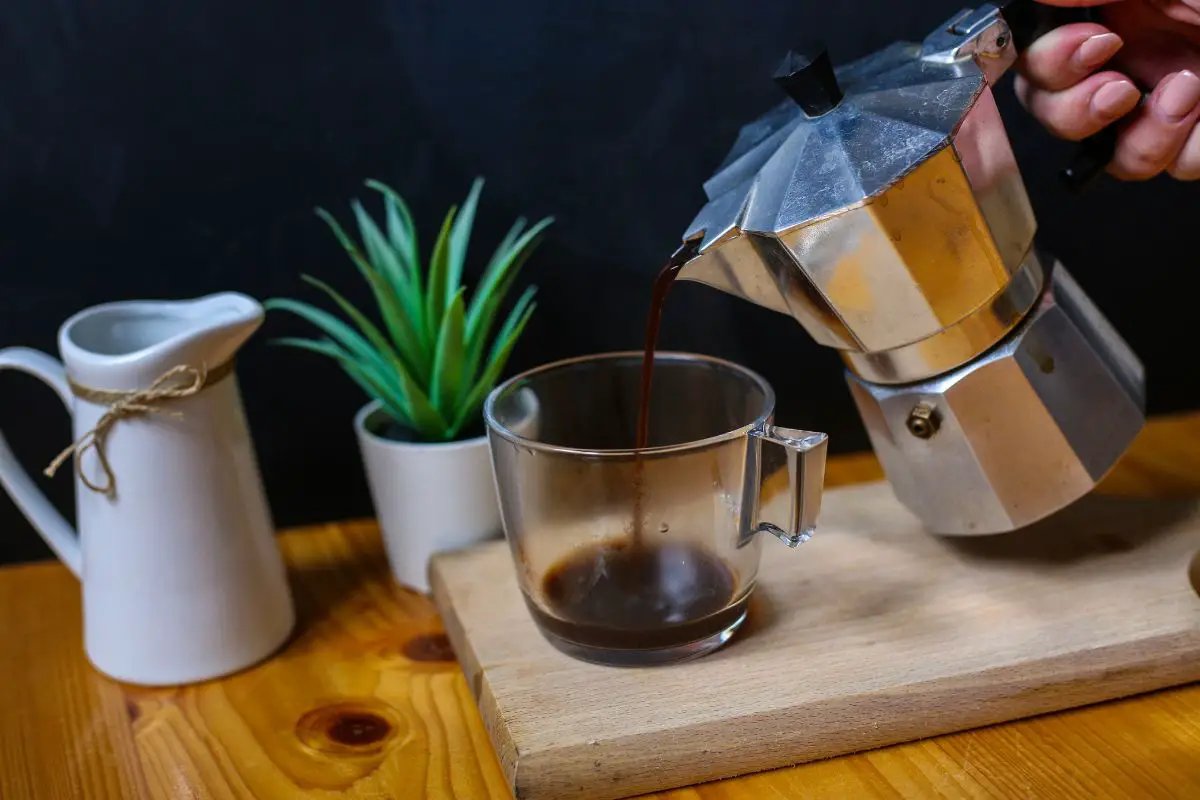In the world of coffee brewing, two methods have gained popularity for their unique qualities and distinct flavors: the Aeropress and the Moka Pot. These brewing techniques, like two mythical creatures battling for dominance, offer coffee enthusiasts an opportunity to explore the depths of their taste preferences.

The Aeropress, known for its versatility and precision, utilizes a combination of immersion and pressure to extract the best flavors from the coffee grounds.
On the other hand, the Moka Pot, reminiscent of a traditional Italian coffee experience, employs steam pressure to create a strong and robust brew.
In this article, we will delve into the intricate brewing processes of both methods, explore the aromatic and flavor profiles they produce, compare their brew times and ease of use, and ultimately help you choose the brewing method that suits your taste preferences and brewing style.
So, grab your safety goggles and join us on this journey of coffee exploration.
Key Takeaways
- Aeropress and Moka Pot are two popular coffee brewing methods.
- Aeropress produces a clean and flavorful cup of coffee, while Moka Pot produces a strong and robust brew similar to Italian espresso.
- Aeropress is known for its quick brew time, convenience, and easy cleaning process, while Moka Pot has a longer brew time, steeper learning curve, and more involved cleaning process.
- The choice between Aeropress and Moka Pot depends on personal preferences, desired taste/strength of coffee, and brewing goals.
Brewing Process of the Aeropress
The brewing process of the Aeropress involves immersing coffee grounds in hot water, followed by pressing the mixture through a filter to extract the desired brewed coffee.
This method begins with preparing the coffee grounds, which should be finely ground to ensure optimal extraction.
Next, the Aeropress is assembled by placing a filter in the filter cap and attaching it to the chamber. The chamber is then placed on top of a sturdy mug.
The coffee grounds are added to the chamber, followed by hot water that is heated to a specific temperature range.
The brewing process starts by stirring the mixture for a predetermined amount of time to ensure proper saturation of the coffee grounds.
After the steeping period, the plunger is gently pressed down, causing the brewed coffee to pass through the filter and into the mug.
The result is a clean and flavorful cup of coffee, with a smooth and balanced taste.
Transitioning into the brewing process of the moka pot, it offers a different extraction method that produces a stronger and more concentrated coffee brew.
Brewing Process of the Moka Pot
The brewing process of the Moka Pot involves several steps. Firstly, the water is filled in the lower chamber, and the coffee grounds are placed in the middle chamber. The Moka Pot is then assembled and placed on a heat source.
As the water heats up, it creates pressure, forcing the water through the coffee grounds and into the upper chamber. The brewing process is relatively quick and produces a strong, concentrated coffee.
The Moka Pot brewing method has its pros and cons. On the positive side, it is a simple and affordable way to make espresso-like coffee at home. The Moka Pot also allows for control over the brewing process, as the strength of the coffee can be adjusted by varying the grind size and the amount of coffee used.
However, some drawbacks include the potential for over-extraction if the coffee is left on the heat source for too long, as well as the need for constant monitoring during the brewing process.
Step-by-step guide to using the Moka Pot
When embarking on the process of utilizing the Moka Pot, one must first familiarize themselves with the intricate steps involved. The following is a step-by-step guide to using the Moka Pot:
- Fill the lower chamber with water, ensuring not to exceed the safety valve.
- Insert the funnel-shaped filter basket into the lower chamber and fill it with finely ground coffee.
- Screw the top chamber onto the lower chamber, making sure it is tightly sealed.
- Place the Moka Pot on a stove over low to medium heat and wait for the water in the lower chamber to boil.
- As the water boils, steam pressure will build up, forcing the water through the coffee grounds and into the top chamber.
- Once the top chamber is filled with brewed coffee, remove the Moka Pot from the heat source and let it cool briefly before pouring.
Understanding the steps involved in using the Moka Pot is crucial for a safe and successful brewing process.
Now, let’s explore the pros and cons of the Moka Pot brewing method.
Pros and cons of the Moka Pot brewing method
One advantage of utilizing the Moka Pot brewing method is its ability to produce a strong and concentrated coffee flavor. This is due to the unique design and brewing process of the Moka Pot. The water is heated in the bottom chamber, creating pressure that forces the water through the coffee grounds and up into the top chamber. This process extracts the flavors and oils from the coffee grounds, resulting in a rich and robust flavor profile.
Additionally, the Moka Pot allows for customization of the strength by adjusting the amount of coffee grounds used. However, it is important to note that the Moka Pot requires careful monitoring and attention during the brewing process to prevent over-extraction or burning of the coffee. This ensures a safe and enjoyable brewing experience.
Moving on to the aroma and flavor profile of aeropress coffee…
Aroma and Flavor Profile of Aeropress Coffee

An important aspect of the aroma and flavor profile of coffee brewed with an Aeropress is its ability to extract a balanced and nuanced range of flavors from the beans. The unique design of the Aeropress allows for a quick brewing process, resulting in a coffee with a clean and vibrant taste.
Here are some key points to consider about the aroma and flavor profile of Aeropress coffee:
- Consistent Extraction: The Aeropress uses pressure to extract the flavors from the coffee grounds, ensuring a consistent extraction and minimizing the risk of over-extraction or under-extraction. This results in a well-balanced cup of coffee with a harmonious blend of flavors.
- Bright and Fruity Notes: The short brewing time of the Aeropress preserves the acidity of the coffee, bringing out bright and fruity notes in the flavor profile. This can include citrus, berry, or floral undertones, adding complexity and depth to the overall taste.
- Clean and Crisp Finish: The paper filter used in the Aeropress traps oils and sediment, resulting in a clean and crisp finish. This enhances the clarity of the flavors and prevents any bitterness or grittiness in the cup.
When comparing the aroma and flavor profile of Aeropress coffee to that of moka pot coffee, it is important to consider the differences in brewing methods and how they can impact the final taste.
Additionally, the materials used in the construction of each brewing device, as well as the brewing time and temperature, play a significant role in shaping the unique characteristics of moka pot coffee.
Aroma and Flavor Profile of Moka Pot Coffee

Moka pot coffee is known for its strong and rich flavor profile. The brewing process of the Moka pot allows for a higher extraction of coffee oils, resulting in a more intense flavor compared to other brewing methods.
Factors that affect the taste of Moka pot coffee include:
- The grind size of the coffee beans
- The water temperature
- The brewing time
All of these factors can be adjusted to achieve the desired flavor profile.
Characteristics of coffee brewed with the Moka Pot
The flavor profile of coffee brewed with the Moka Pot is rich and intense, with notes of caramel and chocolate. This brewing method extracts the oils and flavors from the coffee grounds, resulting in a robust and full-bodied cup of coffee.
Here are five characteristics of Moka Pot coffee that contribute to its unique taste:
- Bold and strong: Moka Pot coffee is known for its strong flavor, making it a preferred choice for those who enjoy a bolder cup of coffee.
- Velvety texture: The Moka Pot brewing process creates a smooth and velvety texture, adding to the overall enjoyment of the coffee.
- Nutty undertones: Alongside the dominant caramel and chocolate notes, Moka Pot coffee often exhibits subtle nutty undertones that enhance its complexity.
- Aromatic aroma: The brewing process of the Moka Pot releases a strong and aromatic scent, filling the room with the enticing fragrance of freshly brewed coffee.
- Lingering aftertaste: Moka Pot coffee leaves a pleasant, lingering aftertaste, allowing the flavors to linger on the palate.
These characteristics make Moka Pot coffee a popular choice among coffee enthusiasts.
Moving forward, it is important to explore the factors that affect the taste of Moka Pot coffee.
Factors that affect the taste of Moka Pot coffee
One crucial aspect to consider when examining the taste of coffee brewed with the Moka Pot is the various factors that can influence its flavor profile. These factors include:
- The type and quality of coffee beans used
- The grind size
- The water temperature
- The brewing time
The type and quality of coffee beans used can greatly affect the taste of the final brew, with different beans having distinct flavor profiles. The grind size also plays a role, as a finer grind can result in a stronger and more intense flavor, while a coarser grind may produce a milder taste.
Additionally, the water temperature and brewing time can impact the extraction process, with higher temperatures and longer brewing times generally leading to a bolder and more robust flavor.
Transitioning into the subsequent section, the comparison of brew time and ease of use further highlights the differences between the Aeropress and Moka Pot brewing methods.
Comparison of Brew Time and Ease of Use
When considering the comparison of brew time and ease of use between the aeropress and moka pot, it is essential to examine the various factors that contribute to the overall efficiency and convenience of each brewing method.
In terms of brew time, the aeropress offers a relatively quick brewing process. It typically takes around 1 to 2 minutes to brew a cup of coffee using the aeropress, making it an ideal choice for those who are short on time or prefer a faster brewing method. On the other hand, the moka pot tends to have a longer brew time, usually ranging from 5 to 10 minutes. This longer brewing process may be less suitable for individuals who require a quicker cup of coffee in the morning.
In terms of ease of use, both the aeropress and moka pot have their advantages and drawbacks. The aeropress is known for its simplicity and ease of cleaning. It consists of fewer parts and can be easily disassembled and rinsed after use. Additionally, the aeropress requires minimal effort and technique to achieve a good cup of coffee.
On the other hand, the moka pot has a slightly steeper learning curve. It requires careful attention to heat and water levels to avoid over-extraction or under-extraction. Additionally, the moka pot requires more time and effort for cleaning due to its multiple components.
The aeropress offers a quicker brew time and easier cleaning process, making it a more convenient option for those who value efficiency and simplicity. However, the moka pot can still produce excellent coffee with a slightly longer brew time and more involved cleaning process. When choosing the right brewing method for you, it is important to consider your time constraints and willingness to invest in learning and maintaining the brewing process.
Choosing the Right Brewing Method for You
When deciding between the Aeropress and Moka Pot brewing methods, there are several factors to consider.
Firstly, one should take into account their personal preferences, such as the desired taste and strength of the coffee, as well as the preferred brewing process.
Additionally, it is important to consider one’s coffee brewing goals, which may include factors such as speed of brewing, ease of use, and portability.
By carefully considering these factors, individuals can make an informed decision on which brewing method is best suited to their needs and preferences.
Factors to consider when deciding between the Aeropress and Moka Pot
To make an informed decision between the Aeropress and Moka Pot, it is essential to carefully consider various factors such as brewing time, coffee strength, and ease of use.
The Aeropress is known for its quick brewing time, typically taking around 1-2 minutes, making it a popular choice for those who are looking for a fast and convenient brewing method.
On the other hand, the Moka Pot takes longer to brew, usually around 5-7 minutes, but it produces a stronger and more concentrated coffee.
Additionally, the Aeropress is relatively easy to use and clean, with a simple plunging mechanism, while the Moka Pot requires a bit more skill and maintenance.
Ultimately, the decision between the two brewing methods will depend on personal preferences and coffee brewing goals.
Personal preferences and coffee brewing goals
Personal preferences and coffee brewing goals play a significant role in the decision-making process between the two brewing methods, the Aeropress and Moka Pot.
When it comes to personal preferences, individuals may have different tastes and preferences for the strength, flavor, and aroma of their coffee. The Aeropress offers more control over the brewing process, allowing users to experiment with variables such as water temperature, brewing time, and grind size.
On the other hand, the Moka Pot produces a stronger and more concentrated coffee with a distinct flavor profile.
Coffee brewing goals also influence the choice between the two methods. If the goal is to brew a quick and convenient cup of coffee, the Aeropress is a better option. However, if the goal is to recreate the rich and intense flavors of espresso at home, the Moka Pot is the preferred choice.
Ultimately, personal preferences and brewing goals should be considered to ensure a satisfying coffee experience.
Frequently Asked Questions
Can I use pre-ground coffee with the Aeropress and Moka Pot?
Pre-ground coffee can be used with both the Aeropress and Moka Pot. However, it is recommended to use freshly ground coffee for better flavor and aroma. Pre-ground coffee may result in a weaker taste due to loss of freshness and oxidation.
How does the brewing process of the Aeropress and Moka Pot affect the caffeine content of the coffee?
The brewing process of the Aeropress and Moka pot can affect the caffeine content of coffee. The Aeropress uses a shorter brewing time and lower temperature, resulting in a lower caffeine extraction compared to the Moka pot, which uses higher temperature and pressure, leading to higher caffeine extraction.
What are the cleaning and maintenance requirements for the Aeropress and Moka Pot?
To ensure proper functioning and longevity of the Aeropress and Moka pot, regular cleaning and maintenance are necessary. This involves disassembling, washing with warm water, and drying thoroughly. Additionally, descaling the Moka pot periodically is crucial for safety and optimal performance.
Can I use the Aeropress or Moka Pot to brew tea or other beverages?
Both the Aeropress and Moka Pot can be used to brew tea or other hot beverages besides coffee. However, it is important to thoroughly clean and maintain the equipment to ensure safety and prevent cross-contamination of flavors.
Are there any specific techniques or tips for achieving a stronger or milder coffee flavor with the Aeropress or Moka Pot?
To achieve a stronger coffee flavor with the Aeropress or Moka pot, consider using a finer grind size, increasing the coffee-to-water ratio, and prolonging the brewing time. Conversely, for a milder flavor, use a coarser grind, decrease the coffee-to-water ratio, and shorten the brewing time.
Conclusion
In conclusion, the comparison between the Aeropress and Moka Pot brewing methods reveals distinct differences in the brewing process, aroma and flavor profiles, as well as brew time and ease of use.
The Aeropress offers a unique and efficient brewing process, resulting in a clean and vibrant cup of coffee.
On the other hand, the Moka Pot provides a rich and bold flavor profile, with a more traditional brewing process.
Ultimately, the choice between these two methods depends on personal preferences and desired coffee experience.
Also read:
